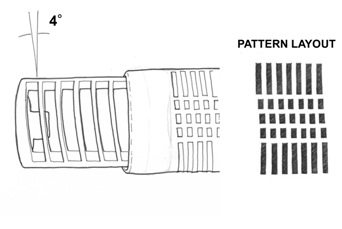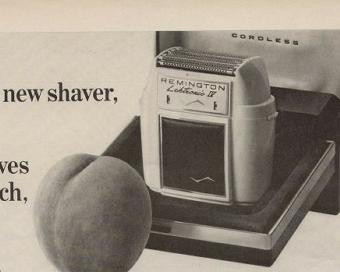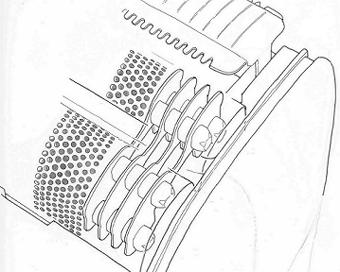■THE BEGINNINGS OF THE SHAVER
Do you know when and by whom the electric shaver (electric razor) you use every morning was made?
■ REMINGTON 
Remington Products Campany L.L.C.
Many companies, including Gillette, entered the electric shaver business created by Schick. Among them, "Remington" is the only existing American brand. The electric shaver created by Jacob Schick was seen as a symbol of a new lifestyle and attracted attention as a new business along with other electrical appliances. Compared to traditional razors that required "water and soap," it was called a DRY SHAVER. Remington, which first commercialized the typewriter for civilian use, also took notice of this DRY SHAVER business and established a shaver division. They actively promoted it at the 1939 New York World's Fair. At the previous Chicago World's Fair, Schick Shavers were promoted, and World's Fairs always became venues for promoting new "things." The Remington brand is also famous in the firearms industry, such as rifles. It is sometimes said to be the same company. Let's look into the origins of this.
・Mergers and Acquisitions: The Evolution of the Brand and Company
1818
Eliphalet Remington started a rifle manufacturing factory in New York in 1818. The company was called E. Remington & Sons.
1873
They first commercialized the QWERTY typewriter. Together with Christopher Sholes (the inventor of the typewriter), they developed a typewriter with an improved key arrangement. The QWERTY layout they adopted has become the standard keyboard layout today. [The third row of the keyboard is arranged as Q-W-E-R-T-Y from the left, hence the name.] There are various theories about why this QWERTY layout was adopted. My favorite story is that a typewriter salesman arranged it in a row so that the word "TYPE WRITER" could be typed quickly (though it seems a bit too convenient).
1886
E. Remington & Sons sold the typewriter business along with the "Remington" brand to the Standard Typewriter Company. Incidentally, E. Remington & Sons later changed its name to Remington Arms, a firearms company. This company also went through several mergers and acquisitions and is now known as Remington UMC, which manufactures rifles and other firearms. Here, the "Remington" of typewriters and the "Remington" of firearms split, and the "Remington" of typewriters would eventually make shavers.
1902
The Standard Typewriter Company changed its name to the "Remington Typewriter Company" due to the high recognition of the "Remington" brand.
1927
The Remington Typewriter Company merged with the Rand Kardex Company to become Remington Rand. This merger made Remington Rand a comprehensive office equipment manufacturer, producing typewriters, calculators, and accounting machines, later dividing the market for punch-card accounting machines with IBM.
1936
The "Electric Shaver Division" was established within Remington Rand. Vice President Harry Rand Seidel created the Electric Shaver Division and served as its director. Schick had invented the electric shaver, and competitors like Packard Lectro Shaver had emerged. 1936 was the dawn of the electric shaver business, and Remington saw potential in this new industry.
1937
The first Remington Shaver MODEL-E: "CLOSE-SHAVER" was released.
1940
Two-blade shaver (TWO HEAD SHAVER) - Remington Dual (REMINGTON DUAL) released.
1941
1955
Remington Rand merged with Sperry Corporation to become Sperry Rand.
1960
1975
1976
"I liked the Remington Shaver so much, I bought the company."
■The shaver division was acquired by Victor Kiam and became independent as Remington Products Inc. This is the direct ancestor of today's Remington Shavers. Victor Kiam himself appeared in TV commercials, claiming, "I liked the Remington Shaver so much, I bought the company," which became a topic of conversation. He appeared in most TV commercials, becoming the brand's icon and driving the business.
■At that time, there was also a Japanese branch, Remington Japan, and all models of Remington Shavers were lined up in Japanese electronics stores with banners saying "America's No.1 Shaver."
■Although they were all large and heavy models, they were said to be the most capable of deep shaving with the combination of two foil blades + a large trimmer. Many are still in use today.
■After this, Sperry Rand merged with Burroughs Corporation to become Unisys.
1995
Victor Kiam sold part of his shares to the investment company Vester Capital Partners, which eventually acquired 40% of the shares. Victor Kiam remained as chairman, but the actual power shifted to Vester Capital.
■From this time, they began to outsource the development and manufacturing of shavers, only producing the heads (outer and inner blades) in-house. The robust product concept that made Victor Kiam say, "I like Remington Shavers..." began to fade, and production bases shifted to China. They also introduced shavers with the "rotary groove blade method" to compete with the "rotary groove blade method" of Norelco, which had the top market share in the American market. Today, Remington Products Inc. offers both the "reciprocating foil method" and the "rotary groove blade method" under the same brand.
2001
Victor Kiam passed away.
bbc NEWS article
2003
Acquired by Rayovac Corporation (an American battery manufacturer), and continues to this day. Rayovac Corporation also acquired the consumer battery division of the German battery manufacturer VARTA, making it the world's third-largest battery manufacturer.
2004
Moved from Bridgeport, Connecticut, where the headquarters had been located for over half a century since the first Remington Rand Shaver Division, to Wisconsin, where Rayovac Corporation is based. Connecticut was the mecca of American electric shavers, including Schick Dry Shaver, Lectro Shaver, and Remington.
They market globally, but their product range is divided between the US
market and other regions. They are under the umbrella of Spectrum Brands
Inc., which controls all the brands owned by Rayovac Corporation. Spectrum
Brands Inc. includes Rayovac and VARTA for batteries, Remington for grooming
products, and three companies each for gardening, insecticides, and pets,
totaling 15 companies. In 2004, the company moved to Wisconsin, and Spectrum
Brands, Inc. directly manages operations within the United States. Spectrum
Brands, Inc., Madison, WI, 53711, U.S.A. http://www.remington-products.com/
In the Japanese market, there was a hiatus after Remington Japan was introduced in the 1980s. In 2003, three models of reciprocating foil shavers (MS3-2000, -3000, -4000) were sold in limited quantities at major electronics retailers, but they are now discontinued. Details to follow...










